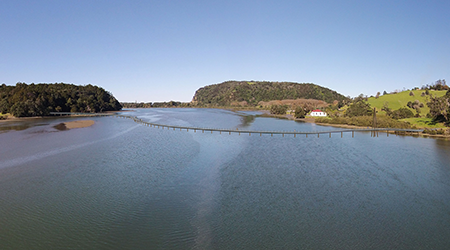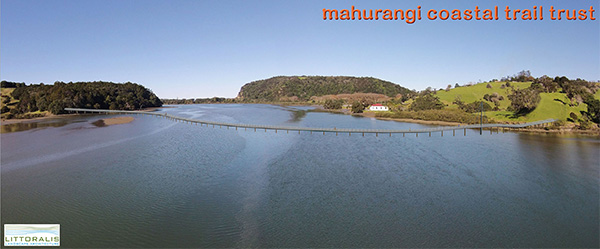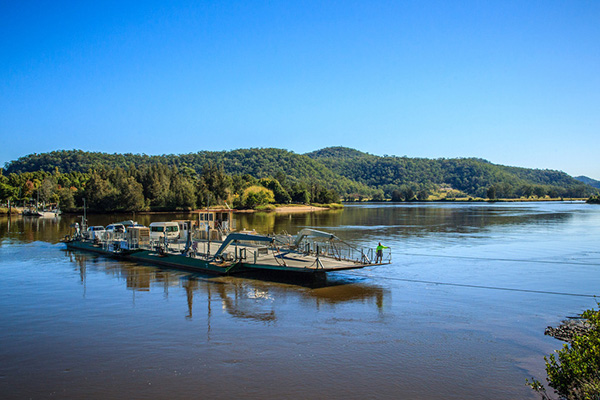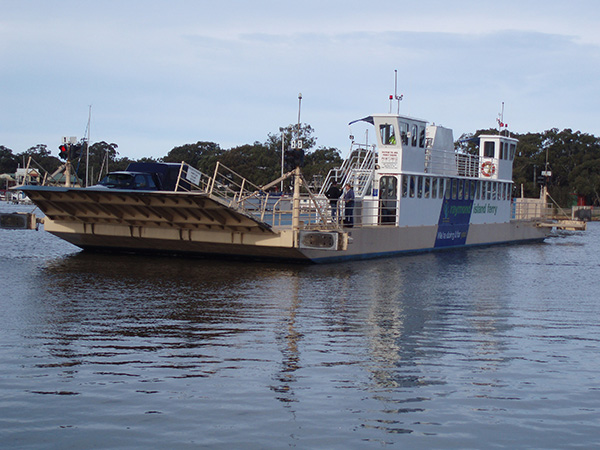Convince the commissioners and Te Muri car-free forever


Best-Current-Thinking Proves Pricey: In an effort to ensure that the landscape and visual impact of the proposed Judge Arnold Turner Footbridge would be acceptable, the Mahurangi Coastal Trail Trust commissioned this visualisation. Whether the ‘elegant footbridge’ concept would have passed muster, in an area that enjoys the highest possible landscape protection, now may not get to be put to the test, given Auckland Council’s estimate that its cost could be $10–$20 million, strongly suggesting that other crossing options should be rigorously revisited. rendering Littoralis Landscape Architecture drone image Majorlook Productions
Auckland Council and the community are now in accord. Scheduled to be published today, are the council’s recommendations to the commissioners who will effectively determine the future of Te Muri.
When the draft management plan was published in November 2015, most of the 140 who had made submissions were utterly flummoxed to learn that Auckland Council was steadfastly adhering to a private vehicle access model that would have shattered the sanctity of Te Muri and which was utterly incompatible with a zero-carbon future.
For eternal optimists it was a suckerpunch, and for the cynical further ‘proof’ that that the so-called supercity sucked. But, in a heartening show of faith, most of the 140 phase-1 submitters, and the many more who hadn’t previously made submissionsa total of 523 submissions, did so in the second, formal, round of consultation without any real reason to believe that this time their viewpoint would be valued. Their faith, or hope, was not in vain; the council’s managers and planners have charitably and unequivocally heeded the call for Te Muri’s sense of splendid isolation to be preserved, and have ruled out private vehicle access as an option. The closest cars will come to the new Te Muri parkland—and this is 10 years away, if it ever happens—is the Hungry Creek Road boundary, or just within it. The scenic ridge farm road will only be used by service vehicles, and thus will be kept suitable to serve as the missing section of Te Araroa.

187-Year-Old Cable-Ferry Crossing: On the Hawkesbury River just 75 kilometres from Sydney’s central business district is Wisemans Ferry, Wenderholm’s closest, and Australia’s oldest, cable-ferry crossing. When demand is high, two ferries operate, on separate sets of cables, but despite that, pleasure boat owners don’t seem to snag themselves when navigating past the ferries. image Scott Bird Heritage Photography
But nor does the council recommend to the commissioners that the key component of the Mahurangi Coastal Trail, the proposed Judge Arnold Turner Footbridge, be immediately given the green light. The council’s coastal engineer has warned that the Mahurangi Coastal Trail Trust’s ‘best current thinking’ regarding a footbridge could cost $10–$20 million, which while not entirely unthinkable, does provide pause, and strongly suggests, and indeed the council recommends, that alternatives to an estuary footbridge be far more rigorously explored, and with the major stakeholders.
Both Mahurangi Action and the Mahurangi Coastal Trail Trust are totally in support of this recommendation, and, in the case of the former, could be said to have been waiting for this moment for 29 years, when the concept of a Mahurangi Coastal Trail was first floated. And floated is an apt verb, because a ferry, or more particularly a chain ferry, near the river mouth, may prove to the most cost-effective option and the one with the least landscape and visual impact. Many New Zealanders will have experienced one or more of Australia’s 28 cable ferries—ferries that winch themselves back and forth across rivers. South Australia and New South Wales have a dozen apiece, except that the latter shares two with Victoria, which has one its own right. Another three operate in Queensland, and Hokianga Harbour hankers after one, to connect Kohukohu and Horeke. There is a cable ferry currently operating in Aotearoa, the Tuapeka Mouth reaction ferry, which powered by the current of the Clutha River on its twin hulls, but as elegant as the principle is, to operate such on a tidal waterway would require a duplicity of cables, and it would lose steerageway at slack water—a maritime collision waiting to happen.
The particular attribute of chain ferries that makes the type applicable to the Pūhoi river mouth is that their cables are chain rather than wire rope, and by being appropriately heavy and incorporating the appropriate amount of slack, sink almost vertically from the ferry, meaning that other craft can navigate past without fear of entanglement. Meanwhile, the virtue of the river-mouth crossing is that it is the estuary’s narrowest point as it passes through the regional park. In fact, not until north of the Johnstone Hill road tunnels does the Pūhoi become as narrow again.

Freedom of Navigation, and from Development: Where a cable ferry needs to work across a narrow and busy waterway, by using chain rather than wire, the cable descends to the riverbed promptly after leaving the ferry, largely eliminating the risk of it being struck by a passing vessel. Fortuitously, for a non-vehicular chain ferry, crossing less-than 50-metre channel at Wenderholm, the swiftly flowing current determines that the ferry should be close to parallel to the channel at all times, allowing it to dock broadside on. This would make it far less likely to be rammed by a passing vessel, or collect up one that had lost steerageway. Pictured is the Raymond Island Chain Ferry, which is so popular with the island’s residents, including because its acts as a bulwark against developers, that they have successfully held off East Gippsland Shire Council engineers’ instincts to bridge the slither of lake that separates them from neigbouring Paynesville and the Australian mainland, and ‘progress’. image Weekend Notes
Aside from the cost of the recent ‘elegant’ footbridge concept, which even if half the lower, $10 million-end of the council’s estimate range, would present a mammoth funding challenge, the biggest drawback of a 400-metre-long structure would be landscape and visual impact. In contrast, a classically styled ferry would be congruously unobtrusive. Nor, however, would a chain ferry completely do away with bridge-like structures—opposing wharves would need to reach out to where there is navigable water at low tide. But, in total they would be little more than an eighth of straight-line distance where the Judge Arnold Turner Footbridge was proposed.
This still leaves the design, construction and operation of the chain ferry itself. But when compared with the scale, cost and complexity of the craft that Peter Thompson has amassed carry out his lifetime ambition of restoring the navigability of the Mahurangi River, a CF Judge Arnold Turner would be a far-from-preposterous community undertaking. And when it comes to operational costs, a ferry has the potential to be self-funding in a way a footbridge—folk expect to pay the ferryman, whereas any attempt to coerce pedestrians into paying a toll to use a footbridge would probably get ugly. Further, by making it clear that the ferry service was manned by unpaid volunteers, the modest charge likely to be made would very likely leave patrons feeling enriched, rather than robbed.
But none of this is to prejudge what a thorough exploration of the various options of crossing the Pūhoi River, including upstream locations for a chain ferry—which sea-level rise will ultimately dictate—might reveal. But nor is it to prejudge the recommendations of the commissioners, which could be for any number of contrary options, including of road access via Mahurangi West. Such a proposal, three decades ago, reached an advanced stage of planning, including geotechnical, before the community convinced the then Auckland Regional Authority that walking was a much more fitting mode of access.
But if the commissioners were to buck both Auckland Council and the community, theirs, technically, would still only be recommendations, and, although unusual, the council’s parks, recreation and sport committee, or indeed its governing body, could reject them in total or in part—even royal commissions don’t get to dictate to democratically elected representatives.
However, none of this is awfully likely, and a muted, interim celebration is entirely in order. But when the management plan variation confirming it finally becomes official, those who have waited three decades for car access to be permanently taken off the table could be excused for pushing the boat, or chain ferry, out.
Then, even teetotal Te Muri devotees might break out the Marlborough.
